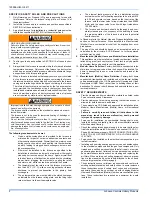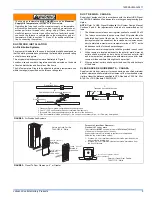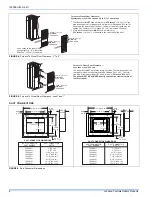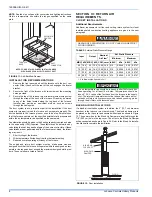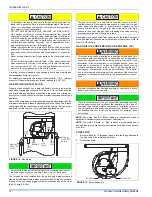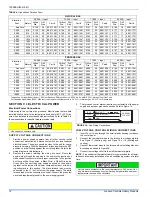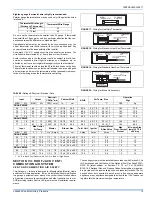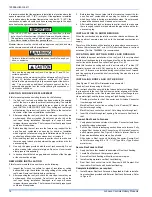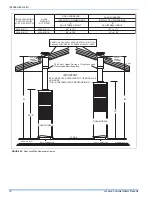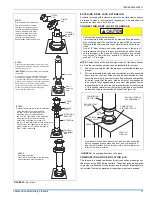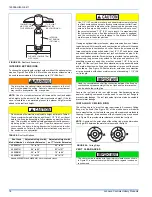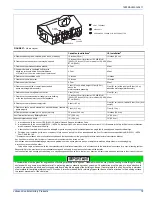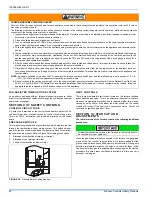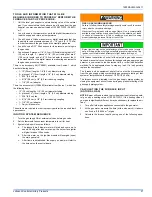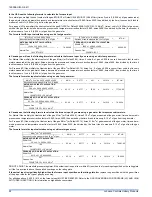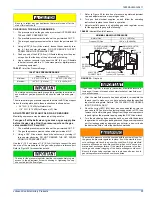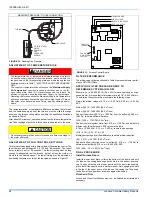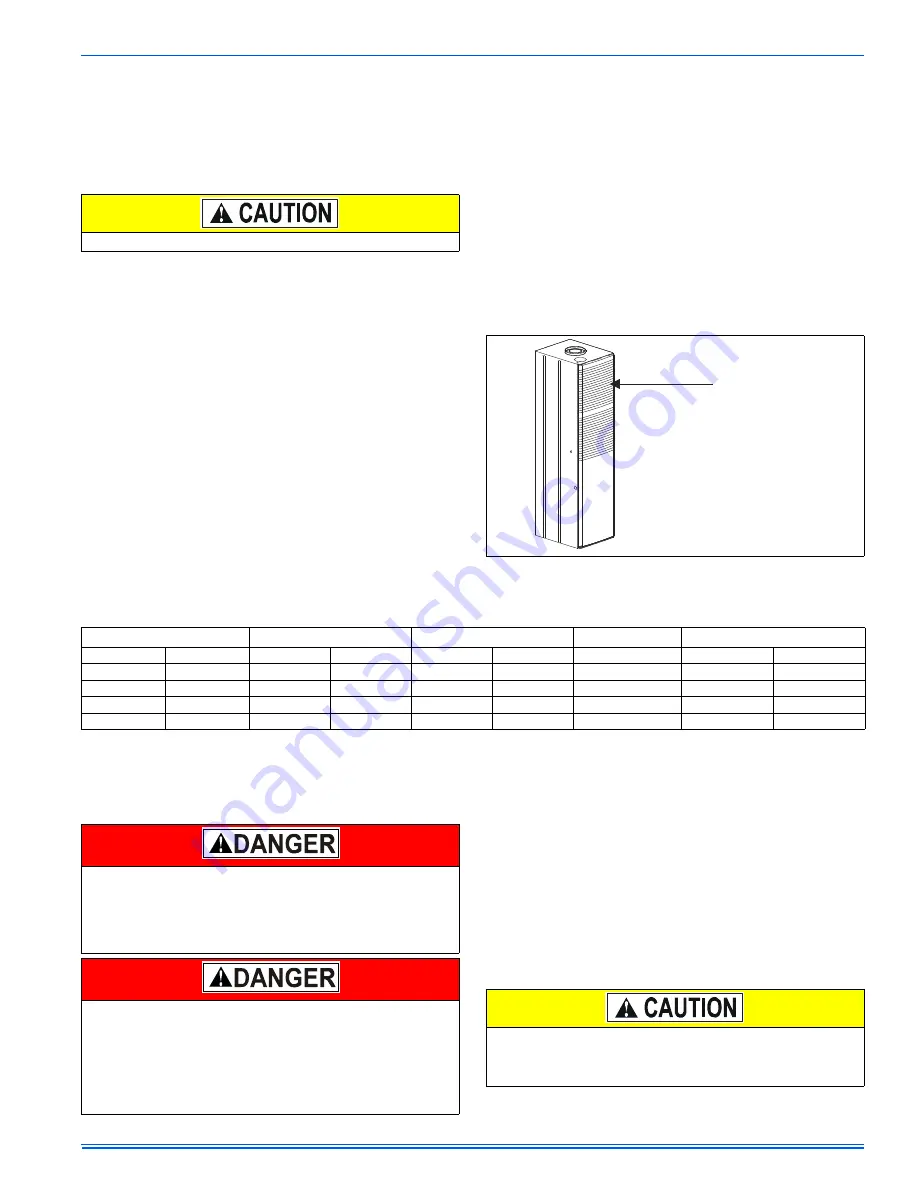
129098-UIM-G-0411
Johnson Controls Unitary Products
9
SECTION IV: FILTERS
FILTER INSTALLATION
All applications require the use of a filter. A standard air filter is located
in the return filter rack on the louvered door. The air filter(s) must be
replaced with air filter(s) that are the same size and same type.
Replacement filter size is shown in Table 3.
Downflow Filters:
There are two types of downflow filter racks.
1.
FURNACE FILTER RACK: A return filter rack with two standard
throwaway type filters are supplied on all models. The return filter
rack is located on the inside of the louvered door. This type of filter
rack is designed for two standard air filters only. Pleated Media or
Washable Filters cannot be used in this filter rack because they
cause too much pressure drop causing a reduction in airflow.
Refer to Figure 13.
2.
EXTERNAL RETURN FILTER GRILLE: The second type is an
external return air filter grille that
can only be used in applica-
tions where the furnace is installed in a closet
. This type of fil-
ter grille is typically installed in a closet door or wall with the filters
located within 12" (30.5 cm) of the return air opening of the fur-
nace. There must be a minimum clearance of 6" (15.2 cm)
between the front of the furnace and the closet door and/or the fur-
nace and the filter grille to prevent the return air flow from being
obstructed. Refer to Table 1 Unit Clearances to Combustibles.
NOTE:
Remove air filters inside louvered door when using an external
filter grille.
a.
If the standard throwaway filter are used the external filter
grille must have a minimum area of 540 in² (3483 cm²) which
would equal a 15" X 36" filter grille.
b.
If the Pleated Media or Washable Filters are used the exter-
nal filter grille must have a minimum area of 684 in² (4413
cm²) which would equal a 18" X 38" filter grille. The increased
area is to reduce the pressure drop across the air filter.
c.
Consideration should be given when locating the return filter
grille for maintenance.
d.
Any filter that has a large pressure drop should be checked to
be sure the pressure drop caused by the air filter will not pre-
vent the furnace from operating within the rise range, speci-
fied on the rating plate and in Table 7. If the furnace does not
operate within the specified rise range then a larger air filter
or an air filter that has a lower pressure drop must be
installed.
SECTION V: GAS LINE INSTALLATION
GAS SAFETY
.
GAS PIPING
Installation and Checking of Gas Line
Gas Supply piping must be sized in accordance with the recommenda-
tions contained in National Fuel Gas Code (ANSI-Z223.1, NFPA-54)
unless local codes or regulations state otherwise.
Materials used and pipe sizing for U.S. manufactured homes must com-
ply with requirements contained in Manufactured Homes A119.1, Rec-
reational Vehicles A119.2 and H.U.D. Title 24, Section 3280.705 and
any local or state codes.
NOTE:
The gas line inlet on the gas valve is 1/2-14 N.P.T. The gas line
may be installed through the furnace floor or furnace side to the gas
valve.
All installations must have a filter installed.
FIGURE 13:
Furnace Air Filters
Air Filters Can Be
Found On The Inside
Of This Panel
TABLE 3:
Filter Sizes - All Models
Input
Output
Air Flow
Cabinet Width
Door Filter
1
1. All Models shipped with disposable filters mounted inside upper furnace door.
2. Pleated filters have high pressure drop and require cleaning every 60 days.
3. Dirty filters can cause excess heating bills, lower air flow, and reduce heat exchanger life.
MBH
kW
MBH
kW
CFM
cmm
In
In
cm
56
16.4
44.8
13.1
1305
34.0
19 3/4
2 - 16 x 20 x 1
2 x 41 x 51
70
20.5
56
16.4
1305
34.0
19 3/4
2 - 16 x 20 x 1
2 x 41 x 51
77
22.5
62
18.1
1305
34.0
19 3/4
2 - 16 x 20 x 1
2 x 41 x 51
90
26.3
72
21.1
1305
34.0
19 3/4
2 - 16 x 20 x 1
2 x 41 x 51
This furnace is designed to operate on NATURAL GAS or PRO-
PANE GAS ONLY. Do Not Burn any other Fuel in this furnace.
Burning any fuel except NATURAL GAS or PROPANE GAS can
cause premature heat exchanger burnout, high levels of carbon
monoxide, excessive sooting, a fire hazard, personal injury, prop-
erty damage and /or death.
An overpressure protection device, such as a pressure regulator,
must be installed in the gas piping system upstream of the furnace
and must act to limit the downstream pressure to the gas valve so it
does not exceed 0.5 PSI (14" w.c. (3.48 kPa). Pressures exceeding
0.5 PSI (14” w.c. (3.48 kPa) at the gas valve will cause damage to
the gas valve, resulting in a fire or explosion or cause damage to
the furnace or some of its components that will result in property
damage and loss of life.
If the gas input to the furnace is too great because of excessive gas
pressure, wrong size orifice, high altitude, etc., the burner flame will
be sooty and may produce carbon monoxide, which could result in
unsafe operation, explosion, and/or fire or asphyxiation.


